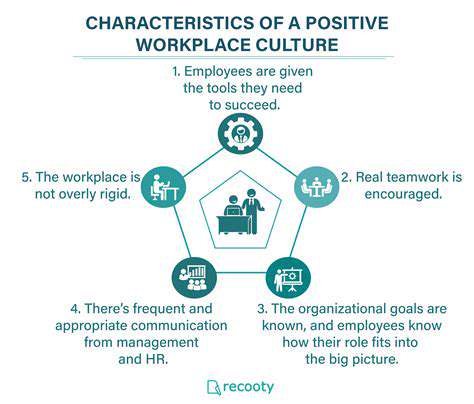The Impact of Persistent Anxiety on Workplace Productivity and Culture
The Relationship Between Anxiety and Workplace Culture

The Role of Leadership in Managing Anxiety
Leadership plays a crucial role in shaping workplace culture, especially in relation to anxiety management. When leaders are attuned to the mental health of their employees, they can create a supportive environment that fosters open discussion about anxiety. This openness can reduce stress levels and build trust among team members. Moreover, showcasing vulnerability by sharing their own challenges can make leaders more relatable. Employees are more likely to seek help if they feel supported by their superiors.
Effective leaders recognize the signs of anxiety and intervene appropriately. They can implement strategies such as flexible work hours or remote working options to accommodate employees dealing with anxiety. This flexibility can significantly boost productivity, as employees feel less pressured and more in control of their work environment.
Additionally, leaders should prioritize wellness programs that focus on mental health resources. Training sessions on stress management and mindfulness can be beneficial for the entire team. By investing in these programs, companies demonstrate their commitment to employee well-being.
Regular check-ins and feedback sessions can also promote a culture of support. Leaders should encourage an open-door policy where employees feel safe to express their concerns without fear of judgment. This not only helps in individual cases but also aids in identifying broader issues within the company.
In conclusion, proactive leadership is vital in managing anxiety and enhancing workplace culture. Through understanding, support, and effective strategies, leaders can cultivate a productive and healthy work environment.
Strategies for Reducing Anxiety in the Workplace
Reducing anxiety in the workplace involves comprehensive strategies that benefit both employees and the organization's overall health. One effective approach is the establishment of clear communication channels. Employees need to know they can express their anxieties without repercussions. Encouraging constructive feedback and regular check-ins can alleviate feelings of isolation and stress.
Providing access to mental health resources is another critical element. Employers should offer workshops, counseling services, and stress management programs to assist employees in coping with anxiety. This access can empower employees to take control of their mental well-being.
Moreover, fostering a flexible work environment can be highly advantageous. Allowing employees to adjust their schedules or work from home can help them manage personal responsibilities and minimize workplace stressors. Such flexibility can significantly enhance job satisfaction and productivity.
Team-building activities can also play a vital role in reducing anxiety levels. Organizing events that promote camaraderie and relationships among colleagues can create a sense of belonging. When employees feel connected, they are better equipped to handle stress and anxiety.
In summary, a multifaceted approach that combines communication, resources, flexibility, and teamwork can substantially reduce anxiety in the workplace, fostering a more reliable culture of support.
The Consequences of Ignoring Anxiety in the Workplace
Ignoring anxiety in the workplace can lead to severe repercussions for both employees and employers. Employees suffering from untreated anxiety often experience decreased productivity and creativity. This can hinder business growth and innovation in a competitive market.
Furthermore, chronic anxiety can result in higher turnover rates. Employees may seek employment elsewhere if they feel their mental health needs are not being addressed. The costs associated with recruiting and training new hires can have a detrimental impact on a company's bottom line.
Cultures that neglect mental health often see an increase in workplace conflicts and tension. Anxiety can manifest in irritability and misunderstandings among colleagues, which disrupts team dynamics. This can lead to a toxic work environment where collaboration is stifled.
In addition, failing to address anxiety can expose organizations to legal risks. Employees may file complaints or lawsuits if they feel their mental health concerns are ignored, leading to reputational damage and potential financial penalties.
In conclusion, neglecting anxiety has far-reaching consequences that can compromise workplace productivity, employee retention, team dynamics, and legal compliance. It is essential for organizations to recognize the importance of addressing anxiety proactively.
Creating a Supportive Work Environment
Creating a supportive work environment is essential for mitigating anxiety among employees. One of the first steps is to cultivate a culture of inclusivity and respect. Employees should feel valued for their unique perspectives and contributions, promoting a sense of belonging. When employees feel appreciated, they are more likely to engage positively with their work.
Regular mental health training and awareness programs can also contribute to a supportive environment. These initiatives can educate staff about the signs of anxiety and how to support colleagues. Understanding anxiety can foster empathy and cohesion among team members.
Furthermore, creating designated relaxation spaces within the office can promote mental well-being. These spaces offer employees a sanctuary where they can take breaks and recharge, ultimately improving their resilience to workplace stressors.
Encouraging a culture of work-life balance is another important aspect. Employers should promote taking regular breaks, vacation time, and avoiding after-hours communication to combat burnout. This balance helps employees manage their responsibilities more effectively and reduces overall anxiety.
In summary, a supportive work environment is characterized by inclusivity, education, designated relaxation areas, and a commitment to work-life balance. By fostering these elements, organizations can create a culture that actively supports mental health and reduces workplace anxiety.
Uncertainty and Its Detrimental Effects on Productivity
Understanding the Nature of Uncertainty
Uncertainty in the workplace can stem from various sources, such as organizational changes, economic instability, or shifting team dynamics. This ambiguity can lead to significant stress among employees, as they may not have a clear understanding of their roles or expectations. This ongoing state of flux creates a mental environment where breaking through the noise to focus on tasks becomes increasingly difficult.
Furthermore, when employees are uncertain about their job security or the stability of their organization, their engagement and motivation tend to diminish. This lack of clarity can hinder decision-making processes, leading to slower project completions and missed deadlines, ultimately impacting overall productivity.
The Psychological Toll of Anxiety
Persistent anxiety in employees can manifest in numerous psychological and physical symptoms, affecting their capacity to perform effectively. Those experiencing anxiety may struggle with concentration, frequently distracted by worries about performance or potential repercussions of their actions. This inability to concentrate can lead to high error rates and an increase in accidents at work.
Moreover, the challenge of managing anxiety can lead to burnout, which further diminishes workplace productivity. When employees are in a constant state of stress, their emotional and physical resources are depleted, resulting in a lack of enthusiasm for their work and reduced creativity. This cycle not only impacts individual performance but can also ripple throughout teams, affecting collaborative efforts.
Creating a Supportive Work Environment
To mitigate the negative impact of anxiety and uncertainty, organizations must create a supportive work environment. Employers can promote open communication and transparency regarding organizational changes and expectations, significantly reducing employee anxieties. Offering resources such as mental health support, flexible work arrangements, and regular check-ins can foster a culture of support.
Additionally, implementing training programs that help employees develop coping strategies for managing anxiety can be beneficial. By equipping staff with the tools to handle stress and uncertainty, organizations can enhance overall morale and productivity, leading to a more resilient workforce capable of navigating challenges with confidence.
Cultivating a Supportive Environment to Mitigate Anxiety

Understanding Anxiety in the Workplace
Persistent anxiety can significantly affect an employee's ability to perform tasks efficiently. Many individuals experience heightened levels of stress and worry, which can lead to decreased focus and productivity. This mental state can create an environment where employees feel overwhelmed and unable to meet their responsibilities.
Furthermore, anxiety can manifest in various ways, such as irritability, fatigue, and absenteeism. When teams are composed of members who struggle with anxiety, the overall morale can plummet. This creates a cycle of low productivity that negatively impacts the entire organization.
Recognizing the symptoms of anxiety in the workplace is essential for management. Awareness can lead to early interventions, such as offering resources and support to those affected. A proactive approach to mental health can foster a more resilient workforce.
The Role of Leadership in Alleviating Anxiety
Leadership plays a crucial role in shaping workplace culture. Leaders who prioritize mental health promote a healthier work environment. By openly discussing anxiety and mental health, leaders can help reduce stigma and encourage employees to seek help.
Encouraging regular check-ins and feedback sessions can also create a culture of support. These practices help employees feel valued and understood, thus reducing feelings of isolation associated with anxiety. A transparent communication style fosters trust and openness among team members.
Moreover, training programs for managers can equip them with the skills to recognize and respond to mental health issues. Educating leaders about the signs of anxiety can enable them to provide timely assistance to struggling employees. By embedding mental health awareness into leadership training, organizations support a healthier work culture.
Strategies for Cultivating a Supportive Environment
Implementing clear communication channels is vital for creating a supportive environment. Employees should feel comfortable expressing their concerns and challenges without fear of judgment. Establishing policies that prioritize mental health can also encourage open discussions about anxiety.
Additionally, flexible work arrangements can help alleviate anxiety. Options like remote work, flexible hours, or reduced workloads can significantly contribute to an employee's well-being. Allowing employees to manage their work-life balance can reduce stress and improve overall productivity.
Promoting wellness programs that focus on mental health is another effective strategy. Workshops, counseling services, and mindfulness practices can provide tools for employees to manage their anxiety. By actively investing in mental health initiatives, organizations demonstrate their commitment to their employees' well-being.
Measuring the Effectiveness of Anxiety Mitigation Strategies
To understand the impact of initiatives designed to reduce anxiety, organizations must measure their effectiveness regularly. Surveys and feedback can provide insights into employee perceptions of support and available resources. Tracking changes in productivity and employee engagement can help gauge the success of these strategies.
Furthermore, analyzing absenteeism and turnover rates can reveal patterns associated with workplace anxiety. Addressing these metrics allows organizations to adapt their strategies to better meet employees' needs. Regular evaluations ensure that mental health remains a priority within the organizational framework.
Ultimately, fostering a culture that prioritizes mental health can lead to long-term benefits. Organizations that invest in their employees’ mental well-being are more likely to see increased loyalty, productivity, and innovation. Creating a supportive environment not only enhances individual well-being but strengthens the entire organization as a whole.